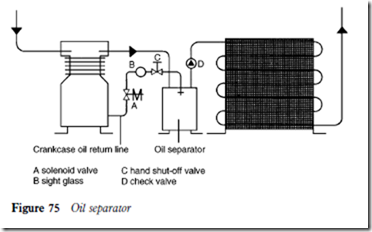Oil separators
A certain amount of oil leaves a compressor with the discharged refrigerant vapour. Large quantities may be prevented from circulating in the system by using an oil separator. Most air conditioning systems employ one of three basic types; the most common is the float type.
Oil returns to the compressor after it has been collected in the separator. The oil separates from the discharged vapour because the vapour flow slows as it enters the separator. When a certain level of oil is reached, the float opens a valve to return the oil to the compressor crankcase.
The oil return line to the compressor crankcase must be of small diameter tubing (6 mm, 0.25 in) or a capillary. This will reduce the oil flow and prevent oil slugging in the compressor.
Some separators are serviceable (bolted construction), some are installed by brazing, and the smaller types have flare connections. An oil separator does not eliminate the necessity for oil traps. Figure 75 shows a typical method of installation.
The accumulator type of separator is used in the larger installations and is located in the suction lines. The bucket type, of much larger construction, is mainly used on industrial systems.
Refrigerant may condense to liquid and collect in the oil separator during long off cycles or during a manual shut-down period of long duration. This refrigerant liquid returning via the oil return line to the compressor could damage the compressor after restart. A check valve in the vapour outlet of the oil separator will reduce the possibility of compressor damage.
A solenoid valve installed in the oil return line and interlocked with the compressor motor starter is common practice. This ensures a positive shut- off in the return line, because the solenoid valve will be energized (open)
only when the compressor is operating, preventing oil and refrigerant from draining to the compressor crankcase during off cycles.
To minimize refrigerant condensation in the oil separator it should be installed as close to the compressor as possible, preferably in a warm location. The separator may be insulated to retard heat loss when the compressor stops.
An indicating sight glass and a hand shut-off valve are installed in the oil return line. In conjunction with the sight glass the shut-off valve can be used as a throttling device; it is adjusted so that liquid flow (oil and refrigerant) from the separator can be controlled to the compressor crankcase.
